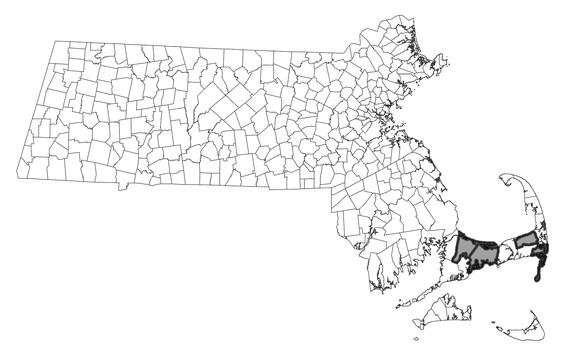- Scientific name: Rhexia mariana
- Species of Greatest Conservation Need (MA State Wildlife Action Plan)
- Endangered (MA Endangered Species Act)
Description
Maryland meadow-beauty is a regionally rare showy perennial wildflower of the meadow-beauty family (Melastomataceae), found along moist open sites of the Massachusetts coastal plain.
Maryland meadow-beauty is a rhizomatous, branched, pubescent perennial, 20-100 cm (8-39 in) in height. The leaves are opposite, commonly 2-5 cm (0.8-2 in) long (but can be up to 8 cm; 3.1 in). They are oblong, or linear-oblong, and three-nerved. The stem is unequally four-sided with one of the pair of sides broad, dark green, and convex, and the other pair narrower, paler, and concave. Pink or white flowers are borne in small clusters near the top of the plant. Each flower has four petals and elongated yellow to orange anthers (pollen-bearing structures) that angle downwards on the ends of hooked stamens. The fruit is a reddish, urn-shaped capsule that contains many tiny, tan to brown seeds. Maryland meadow-beauty flowers from August to September.
Maryland meadow-beauty resembles and can co-occur with the far more common Virginia meadow-beauty (Rhexia virginica). When in bloom the two species are easily distinguished, as Virginia meadow-beauty has darker pink to rose petals. Virginia meadow-beauty also has broader leaves and an equally four-sided, slightly winged stem. Lastly, Virginia meadow-beauty is generally less branched than its congener.
Life cycle and behavior
This is a perennial species.

Population status
Maryland meadow-beauty is listed under the Massachusetts Endangered Species Act as Endangered. All listed species are legally protected from killing, collection, possession, or sale, and from activities that would destroy habitat and thus directly or indirectly cause mortality or disrupt critical behaviors. MassWildlife’s Natural Heritage & Endangered Species Program database has 9 records from 1 county (Barnstable). All 9 records are from Barnstable County, and 5 of those records are within the last 25-year period.

Distribution in Massachusetts
1999-2024
Based on records in the Natural Heritage Database
Distribution and abundance
The documented range of Maryland meadow-beauty extends from Massachusetts to Florida and throughout much of the Midwest. Massachusetts has its only New England stations.
Habitat
Maryland meadow-beauty inhabits moist, open, peaty or sandy sites, usually associated with coastal plain ponds (e.g., shores, associated marshes, wet grassy places). The species is dependent on fluctuating water levels and may not appear every year. Associated species include highbush blueberry (Vaccinium corymbosum), marsh-rush (Juncus canadensis), Plymouth gentian (Sabatia kennedyana; Special Concern), rose coreopsis (Coreopsis rosea, Watch List), slender-leaved goldenrod (Euthamia graminifolia), steeplebush (Spiraea tomentosa), thread-leaf sundew (Drosera filiformis), and Virginia meadow-beauty (Rhexia virginica).
Healthy habitats are vital for supporting native wildlife and plants. Explore habitats and learn about conservation and restoration in Massachusetts.
Threats
Threats include any activities that change the natural hydrology, water quality, or soil integrity of its habitat. Examples include water table drawdown from local wells, eutrophication resulting from nutrient inputs from septic systems and lawns and trampling and soil disturbance due to recreational use of pond shores (i.e., hiking, sunbathing, swimming, fishing, boat-launching, and raking or digging).
Conservation
Preservation of Maryland meadow-beauty requires protection of the natural hydrology, water quality, and soil integrity of its habitat. Like other coastal plain pond shore associates, it requires pronounced water-level fluctuations, and acidic, nutrient-poor water and substrate, free from major soil disturbance.
Maryland meadow-beauty populations should be monitored regularly to identify possible threats. Protection of Maryland meadow-beauty may require the exclusion of new wells and septic systems, prohibitions on fertilizer use, and restrictions on recreational use of the pond shores. Prolonged artificial water level draw-down can encourage shrubby species to displace Maryland meadow-beauty. Recreational activities such as swimming, fishing, and boat launching should be diverted from plant population locations by providing alternative locations for these activities. Also, habitat should be monitored for exotic plant species’ invasions. The nature of coastal plain ponds makes them generally inhospitable to many exotic plants, but they can become established at sites that have major soil disturbance or heavy nutrient inputs. Exotic species that could establish along the shoreline of coastal plain ponds include common reed (Phragmites australis ssp. australis), gray willow (Salix cinerea), and purple loosestrife (Lythrum salicaria). All active management of rare plant populations (including invasive species removal) is subject to review under the Massachusetts Endangered Species Act and should be planned in close consultation with the MassWildlife’s Natural Heritage & Endangered Species Program.
Contact
| Date published: | May 6, 2025 |
|---|